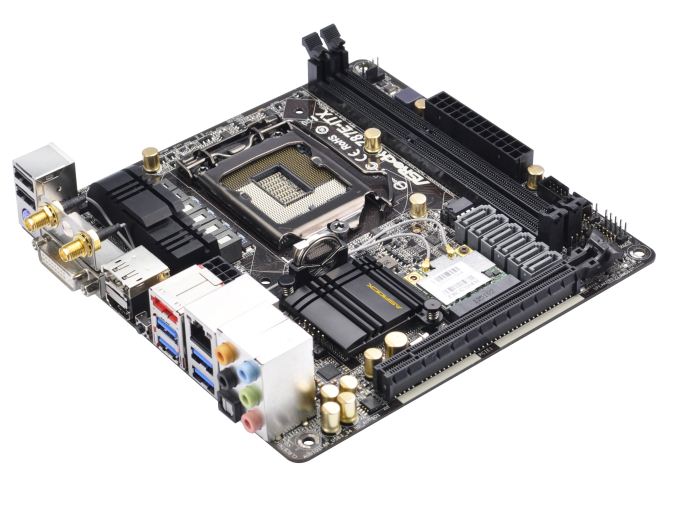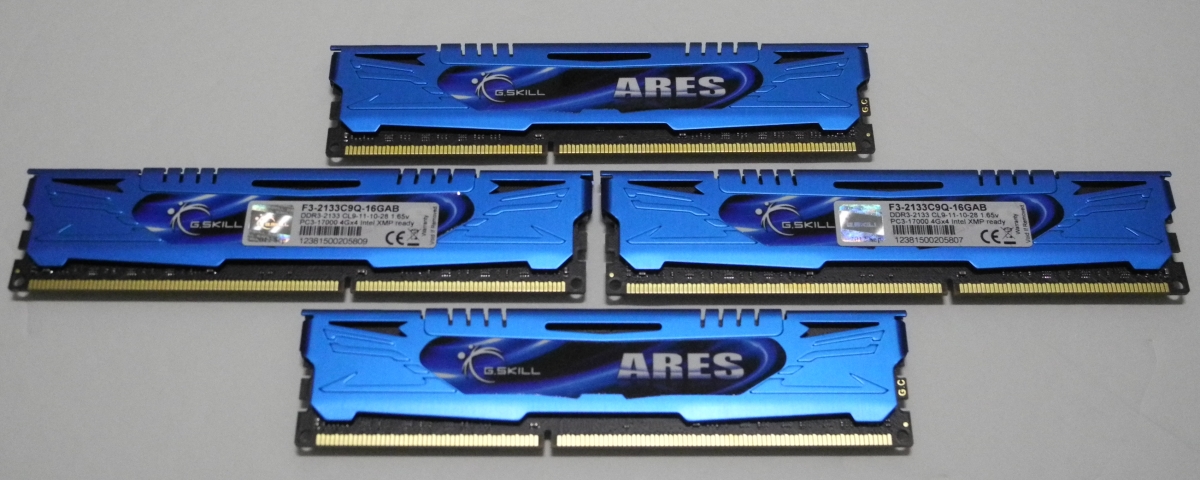Intel's Haswell - An HTPC Perspective: Media Playback, 4K and QuickSync Evaluated
by Ganesh T S on June 2, 2013 8:15 PM ESTTestbed and Software Setup
Instead of going for the usual high end CPU (77W / 95W TDPs), we have opted for the Core i7-4765T for today's review. This is a 35W TDP CPU with four cores / eight threads, expected to retail with a MSRP of $303. Intel has a number of GPU configurations doing the rounds at Haswell launch. The i7-4765T sports the HD 4600 GPU, and it is the best GPU available in a LGA 1150 configuration (The Iris Pro 5200 GPUs are reserved for BGA configurations and unavailable to system builders).
The table below presents the hardware components of our Haswell HTPC testbed
| Haswell HTPC Testbed Setup | |
| Processor | Intel Core i7-4765T - 2.00 GHz (Turbo to 3.0 GHz) |
| Intel HD Graphics HD4600 - Up to 1200 MHz | |
| Motherboard | ASRock Z87E-ITX mITX |
| OS Drive | Seagate 600 SSD ST240HM000 240GB |
| Memory | G.SKILL Ares Series 8GB (2 x 4GB) SDRAM DDR3 2133 (PC3 17000) F3-2133C9Q-16GAB CAS 9-11 -10-28 2N |
| Optical Drive | ASUS 8X Blu-ray Drive Model BC-08B1ST |
| Case | Antec Skeleton ATX Open Air Case |
| Power Supply | Antec VP-450 450W ATX |
| Operating System | Windows 8 Professional x64 |
| Displays / AVRs | Onkyo TX-SR606 + Acer H243H |
| Pioneer Elite VSX-32 + Sony Bravia KDL46EX720 | |
| Sony XBR-84X900 | |
| Seiki Digital SE50UY04 | |
The ASRock Z87E-ITX board comes with a Broadcom-based 802.11ac 2T2R solution. Connected to a Buffalo WZR-D1800H 802.11ac router, I was able to consistently obtain 173 Mbps of practical throughput. Streaming Blu-ray ISOs over Wi-Fi from a NAS worked without issues. The board was very simple to get up and running and given its form factor and the CPU currently installed, I hope to migrate it to a passive HTPC build soon.
The Haswell platform officially supports DDR3-1600. Towards this, we obtained a 16 GB DDR3-2133 Ares kit from G.Skill for our testbed. The Ares kit supports XMP 1.2 and the ASRock Z87E-ITX had it running at 2133 MHz flawlessly on first boot. However, we made sure to run the memory at the suggested 1600 MHz in order to obtain results consistent with what an average system builder (non-overclocker) would obtain. The Ares kit makes it possible to study HTPC behaviour from a memory bandwidth perspective, but we will not cover that aspect in this launch piece.
The software setup for the Haswell HTPC testbed involved the following:
| Haswell HTPC Testbed Software Setup | |
| Intel Graphics Driver | 9.18.10.3107 (Version on ASRock Motherboard DVD) |
| Blu-ray Playback Software | CyberLink PowerDVD 13 |
| Media Player | MPC-HC v1.6.7.7114 |
| Splitter / Decoder | LAV Filters 0.57 |
| Renderers | EVR / EVR-CP (integrated in MPC-HC v1.6.7.7114) |
| madVR v0.86.1 | |
The madVR renderer settings were fixed as below for testing purposes:
- Decoding features disabled
-
Deinterlacing set to:
- automatically activated when needed (activate when in doubt)
- automatic source type detection (i.e, disable automatic source type detection is left unchecked)
- only look at pixels in the frame center
-
Scaling algorithms were set as below:
- Chroma upscaling set to SoftCubic with softness of 100
- Luma upscaling set to Lanczos with 4 taps with anti-ringing filter left deactivated and scale in linear light left unchecked / DXVA2
- Luma downscaling set to Lanczos with 4 taps with anti-ringing filter left deactivated and scale in linear light left unchecked / DXVA2
-
Rendering parameters were set as below:
- Automatic fullscreen exclusive mode was used
- CPU and GPU queue sizes were set to 32 and 24 respectively
- Under exclusive mode settings, the seek bar was enabled, switch to exclusive mode from windowed mode was delayed by 3 seconds and 16 frames were configured to be presented in advance. The GPU flushing modes were set to default
- Smooth motion was left disabled
- The 'trade quality for performance' settings were left at default (i.e, linear light was left disabled for smooth motion frame blending and custom pixel shader results were stored in 16-bit buffers instead of 32-bit)
Unlike our Ivy Bridge setup, we found the windowed mode to be generally bad in terms of performance compared to exclusive mode.
MPC-HC and LAV Filters settings were altered from the defaults as below for testing purposes:
- DirectShow Video Output was configured as EVR / EVR-CP / madVR under Options > Playback > Output
- All internal source and transform filters were disabled under Options > Internal Filters
- Under Options > External Filters, LAV Splitter, LAV Audio Decoder and LAV Video Decoder were added as Preferred filters
- LAV Audio Decoder was set to bitstream all applicable formats
-
LAV Video Decoder were altered from the defaults as below
- Hardware Acceleration was set to DXVA2 Native / QuickSync / None depending on the aspect being tested. UHD (4K) was enabled in all the cases
- Deinterlacing mode was set to 'Aggressive'












95 Comments
View All Comments
jhoff80 - Sunday, June 2, 2013 - link
This article and the power consumption stats just make me wish that Intel would just make it easier to get a hold of their -T chips for end users. A 35W or 45W chip would be great for me, but the only thing that has full retail availability is the 65W one. (And it's not because it's so early in launch, it's always been way too difficult to get -T versions.)EnzoFX - Sunday, June 2, 2013 - link
Not to mention expensive! You get the same results by undervolting/underclocking, typically.Laststop311 - Monday, June 3, 2013 - link
You are correct in a way but you could undervolt the T series as well and get better thermal performance then the 65 watt version. atleast that is my experience. If i was making an HTPC i would use the i7-4770t or the i7-4650t if thats the equivalent of the i7-3770t this year. The power consumption is amazing and proper 24hz is great for 1080p24 playback. upgrade to the htpc just isn't in my budget right now and ivy bridge + gt 660 isnt a bad htpc. MY PC budget is going to an ultrabook upgrade this year. The increased battery life and performance is insane. i7-980x desktop still does not have a large enough upgrade to make it worth it. Ivy bridge-E is not THAT much faster and I dont think even haswell-e next year will be enough to upgrade the desktop.Death666Angel - Tuesday, June 4, 2013 - link
"but you could undervolt the T series as well and get better thermal performance then the 65 watt version."Not to the same extent. The T series will already be driving much tighter voltages than normal SKUs. While you may save 15% power consumption by undervolting normal SKUs, undervolting already power efficient SKUs would result in sub 5% probably.
vnangia - Sunday, June 2, 2013 - link
Well, it helps that there are 35W parts this time around - at least on the timeline. IVB didn't get any 35W parts, so the HTPC is still on SNB, and yeah, I could definitely use the incremental improvements to QuickSync.jhoff80 - Sunday, June 2, 2013 - link
Yes, but I'm not talking about only 35W specific chips. The i7-3770T was just as difficult to get as any other -T series chip, because they don't sell them to end-users directly.vnangia - Sunday, June 2, 2013 - link
I'm agreeing with you! What I was trying to say is, Intel did announce low-TDP SNB parts and delivered: SNB had a bunch of -T versions available to end-users at both low (G4xx, G5xxT, 2100T, 2120T) and high end (2390, 2500T). I bought my 2100T at Microcenter B&M for instance.By contrast, Intel didn't announce any end-user -T (and just a handful of -S) parts and we saw that IVB had virtually no -T parts available. I'm optimistic that now they've announced a few -T parts at the high end, we might actually see these materialize in the retail chain and hopefully it bodes well for -T parts at the low end.
Fortunately (*knocks on wood*) the current SNB-based HTPC is still going strong, so I don't feel the need to upgrade. If and when I do, though, I expect that it won't be so clear cut - I may end up going with AMD's lineup, despite the relative paucity of AMD ITX boards.
jhoff80 - Monday, June 3, 2013 - link
Sorry, I must've misunderstood.Krysto - Monday, June 3, 2013 - link
This is insane. Why use a $400 Intel Haswell media box for 4k video, when you can use the much cheaper and much more efficient Mali T622-based media boxes that should be appearing next year?http://blogs.arm.com/multimedia/977-a-new-branch-f...
NirXY - Monday, June 3, 2013 - link
"should be appearing next year"